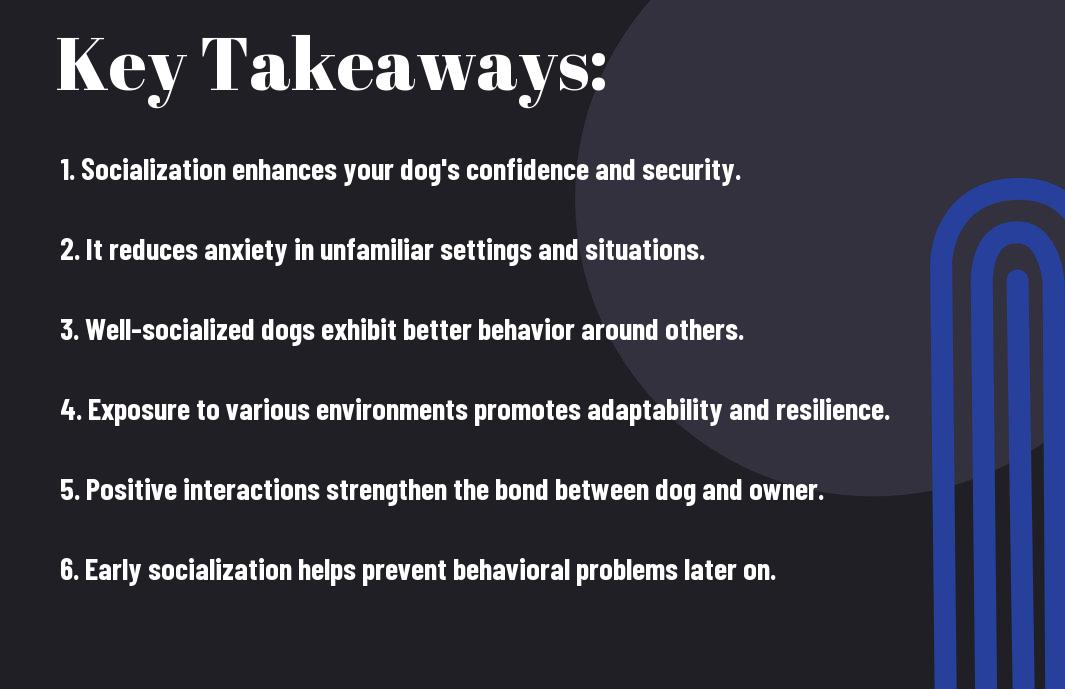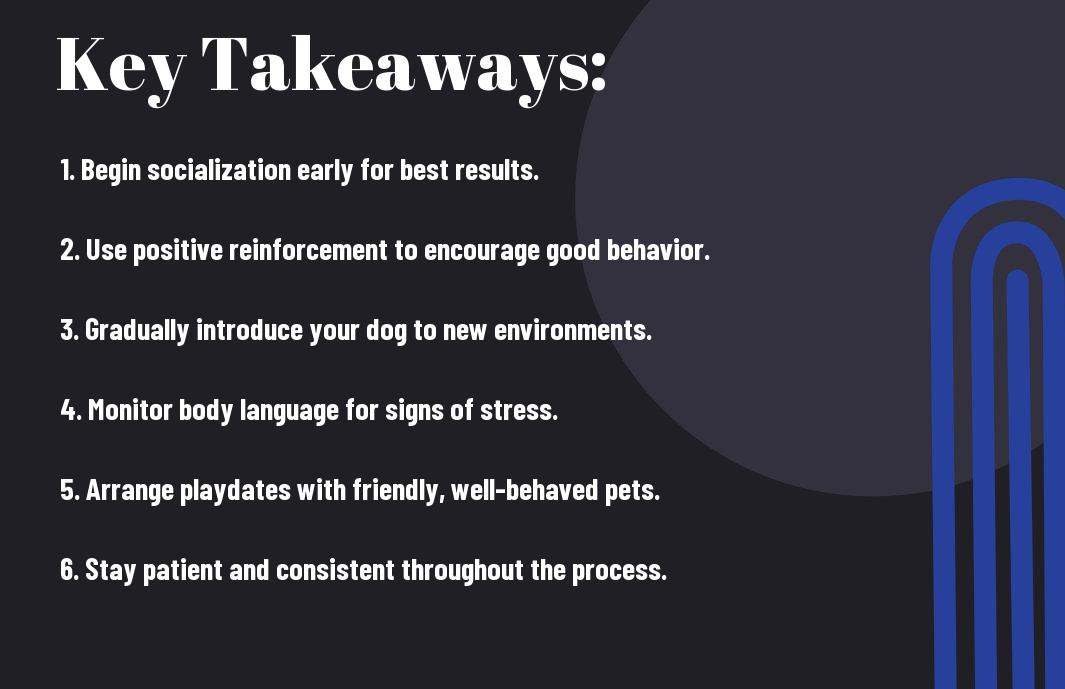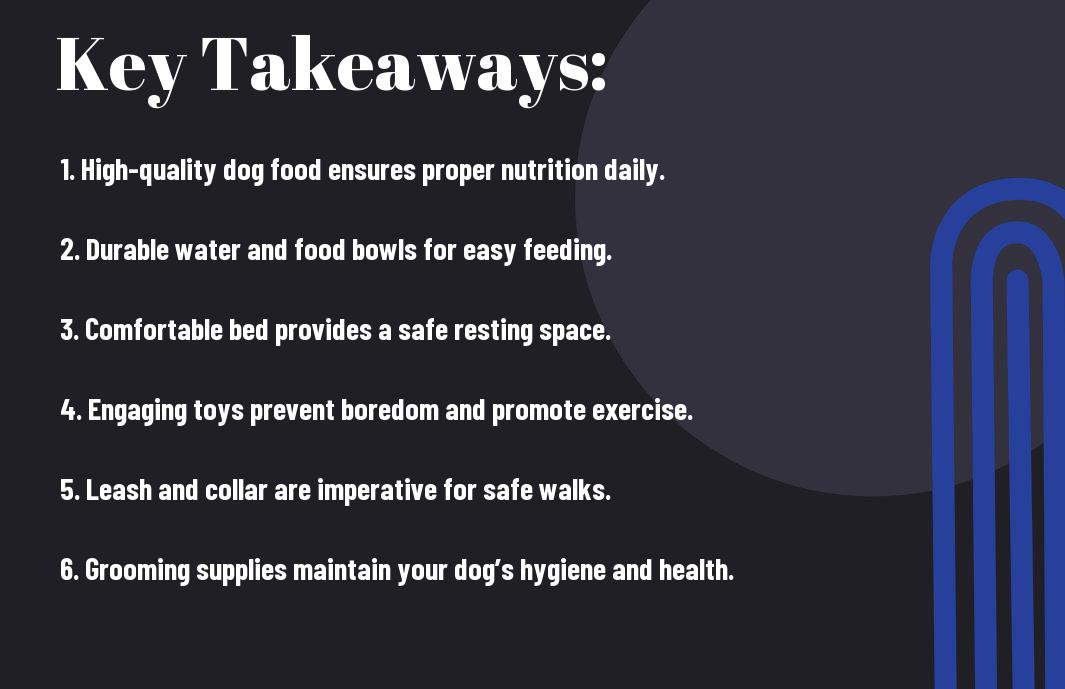Many dog owners underestimate the significance of socialization in their pets’ lives. By exposing your dog to a variety of people, environments, and other animals, you help them develop confidence and prevent behavioral issues such as fear and aggression. Proper socialization not only leads to a more well-adjusted pet but also enhances their ability to interact positively in diverse situations. Investing time and effort into your dog’s social skills is crucial for fostering their overall well-being and ensuring they live a happy, fulfilling life.


Understanding Dog Socialization
While you may already know that socializing your dog is important, understanding what socialization truly entails can help you better appreciate its significance in your dog’s life. Dog socialization is the process of exposing your canine companion to a variety of situations, environments, people, and other animals in a positive manner. This exposure helps your dog learn appropriate behaviors and reduces the likelihood of fear or aggression later in life. When you think of socialization, it’s about creating positive experiences that build your dog’s confidence and adaptability in different circumstances.
Definition of Socialization
On a fundamental level, socialization is not just about interacting with other dogs; it includes a wide array of experiences that contribute to your dog’s overall development. Proper socialization involves introducing your dog to various sounds, sights, and sensations that they will encounter in everyday life. This could include meeting new people, visiting parks, or even riding in a car. The goal is to ensure that these experiences foster a mindset of curiosity and comfort rather than fear or anxiety.
Developmental Stages of a Dog’s Life
After understanding what socialization means, it’s important to recognize that your dog’s life is divided into several developmental stages, each requiring different socialization strategies. From puppyhood to adulthood, your dog’s socialization needs will change significantly. During the critical socialization period, which typically occurs between 3 to 14 weeks of age, puppies are most receptive to new experiences. Exposing your puppy to diverse environments, sounds, and other animals during this stage can lay the foundation for a well-adjusted adult dog.
Understanding your dog’s developmental stages can guide you in selecting the right opportunities for socialization. For instance, early exposure to different people and experiences during their youth can lead to a dog that is more adept at handling various situations as they grow older. On the other hand, a lack of socialization during these early stages can lead to behavioral issues like fearfulness or aggression in adulthood. The key takeaway is that timely and varied experiences during the critical socialization window can have a lasting positive impact on your dog’s behavior and happiness throughout their life.
Benefits of Socialization
Clearly, the benefits of socialization cannot be overstated. When you provide your dog with opportunities to interact with other dogs and people, you are setting the foundation for their overall well-being. The more experiences your dog has, the more equipped they are to handle different situations, which leads to an enriched life.
Emotional Well-being
To ensure your dog has a healthy emotional state, socialization is key. This helps to build their confidence, making them less likely to experience anxiety or fear in new situations. A dog that is well-socialized is often more balanced and able to navigate various environments without becoming stressed. You will notice that your dog feels relaxed and at ease, whether they are riding in the car, visiting a park, or meeting new people.
Moreover, socialization encourages positive interactions, which can lead to less aggressive behavior or fear-based reactions. By exposing your dog to a variety of situations and individuals, you allow them to learn appropriate behaviors and responses, fostering a more emotionally stable companion.
Behavioral Improvements
At the center of improved behavior is the socialization process that helps modify unwanted habits in your dog. By engaging with other dogs and humans, your canine will learn from social cues and appropriate boundaries, reducing tendencies toward *destructive behavior*, such as barking or chewing.
Improvements in behavior will become evident as your dog starts to thrive in social settings. You may find that they begin to listen better to commands, engage less in *nervous behaviors*, and respond more appropriately to situations that might have previously triggered fear or aggression. A well-socialized dog typically displays better manners both at home and in public, making your outings more enjoyable and less stressful.
Enhanced Physical Health
Enhanced physical health is another significant advantage of socialization that often gets overlooked. Engaging with other dogs allows your pet to partake in vital physical activities and play, which keeps them fit and promotes a healthy weight. Moreover, socialization can lead to regular exercise, which is crucial for your dog’s cardiovascular health.
Indeed, a physically healthy dog is generally more content and has a stronger immune system. This physical well-being impacts their overall vitality and longevity, so the importance of regular social interactions cannot be underestimated. When you prioritize your dog’s socialization, you are not only enhancing their social skills but also fostering a healthier and more active lifestyle.

Types of Socialization Experiences
Once again, understanding the various types of socialization experiences is necessary for enhancing your dog’s well-being. Proper socialization can significantly improve your dog’s behavior and reduce anxiety, making it an important aspect of responsible dog ownership. Here are some key types of socialization experiences that you should consider:
| Interaction with Other Dogs | Allows dogs to learn communication skills and develop friendships. |
| Exposure to New Environments | Familiarizes your dog with different surroundings, reducing fear. |
| Meeting New People | Teaches your dog to behave calmly around strangers. |
| Training Classes | Provides structured interaction with other dogs and humans. |
| Participating in Dog-Friendly Events | Exposes your dog to large groups and new experiences. |
Interaction with Other Dogs
Types of socialization experiences, such as interaction with other dogs, play a pivotal role in your dog’s behavior. By engaging with their canine companions, dogs learn important social skills, including how to communicate effectively through body language and vocalizations. This interaction not only helps them make friends but also teaches them how to assert themselves and recognize boundaries.
However, it’s necessary to monitor these interactions closely. Some dogs may feel overwhelmed or intimidated, potentially leading to aggressive behaviors. When socializing your dog with others, ensure they are in a safe and controlled environment, allowing them to explore new friendships without the risk of stress or conflict.
Exposure to New Environments
Socialization extends beyond just meeting other creatures; it also involves exposure to new environments. Taking your dog to various locations, such as parks, pet-friendly stores, or busy streets, helps them adapt to different scenarios. This exposure can diminish anxiety and build confidence, ensuring your dog feels comfortable in various settings.
When introducing your dog to new environments, start with less stimulating locations and gradually increase the level of distraction. This way, your dog can adjust more comfortably, promoting a smooth transition into new experiences.
In addition, fostering your dog’s comfort with new environments can significantly reduce their fear of unfamiliar situations down the line. By regularly exposing them to varied settings, you contribute to their overall mental well-being.
Meeting New People
Above all, meeting new people is another necessary aspect of your dog’s socialization journey. Your dog should learn to interact positively with strangers and understand that not all people pose a threat. This skill can seamlessly translate into calmer behaviors in everyday encounters, making walks and outings much more enjoyable for both of you.
As your dog meets new people, allow them to approach at their own pace while reassuring them with positive reinforcement. This method encourages your dog to feel secure and confident in unfamiliar situations, strengthening their social skills in the process.
In fact, the more your dog encounters different individuals, the more they learn about various social cues. This diversifies their experiences and may reduce overly excited or fearful reactions during unexpected interactions with new people.
Recognizing the importance of these socialization experiences will greatly enhance your dog’s overall behavior and happiness. By taking the time to expose your dog to different social settings, you set them up for a well-adjusted and fulfilling life.
The Role of Obedience Training in Socialization
Keep in mind that obedience training forms the foundation of your dog’s ability to interact positively with others. It enables them to respond to your commands, establishing a line of communication that enhances their behavior in social settings. By teaching basic commands like “sit,” “stay,” or “come,” you create a framework that helps your dog navigate different environments and situations, thereby reducing the likelihood of unwanted behaviors that can stem from anxiety or fear. This not only makes outings more enjoyable for you but also contributes to your dog’s overall mental health and well-being.
Basic Training Fundamentals
For effectiveness, the execution of basic training should occur in a variety of settings. This exposure allows your dog to practice their obedience in different environments, which is vital for their socialization. Keep sessions short and positive to maintain your dog’s interest and enthusiasm. Your consistency in commands and rewards helps your dog understand what is expected, reinforcing their learning and boosting their confidence.
Building Confidence Through Training
One of the primary benefits of obedience training is the boost in confidence it provides to your dog. As they successfully learn commands and execute them well, they become more self-assured and less reactive to new stimuli. This newfound confidence can make them less anxious in unfamiliar situations. When your dog knows that they can rely on you for guidance, they are more likely to feel safe and secure, influencing how they interact with both people and other animals.
Building this confidence is significant for your dog’s overall demeanor and ability to cope with social interactions. Engaging in group training classes offers additional benefits, as they provide your dog with the opportunity to meet and interact with other dogs in a controlled environment. This not only reinforces the obedience commands you teach but also aids in developing healthy relationships and social skills. Therefore, dynamic training that combines obedience commands with socialization practices is imperative for fostering a well-adjusted and happy companion.
Socialization Techniques
After understanding the significance of socialization in your dog’s life, it’s vital to explore effective techniques that can facilitate this process. These techniques not only help mitigate behavioral issues but also enhance your dog’s overall emotional and mental health. With intentional practice and the right approach, you can significantly improve your canine companion’s ability to interact with the world around them.
Positive Reinforcement Methods
Across dog training, positive reinforcement stands out as an exceptionally effective technique for socialization. This approach involves rewarding your dog for exhibiting desired behaviors, such as calmness around new people or other dogs. By using treats, praise, or play as incentives, you can encourage your dog to feel more comfortable and confident in unfamiliar situations. This not only fosters a bond between you and your dog but also transforms potentially stressful encounters into positive experiences.
Across various scenarios, positive reinforcement can be adapted to suit your dog’s specific needs. For instance, when introducing your pup to new environments, start with low-stress situations. If your dog displays curiosity or calm behavior, promptly reward them. Over time, your dog will begin to associate new experiences with positive outcomes, leading to improved social skills and a more relaxed demeanor in diverse settings.
Gradual Exposure Strategies
Across different settings, implementing gradual exposure techniques can profoundly affect your dog’s comfort level when encountering new stimuli. The essence of this approach is to slowly introduce your dog to new experiences in a controlled manner. Start with low-intensity situations that your dog can handle and gradually increase the complexity as their confidence builds. For example, if your dog is fearful of larger dogs, introduce them to smaller and calmer breeds before progressing to larger or more active dogs.
Methods of gradual exposure can involve breaking down the process into manageable steps, ensuring each exposure is positive and rewarding. By doing this, you enable your dog to acclimate to new experiences without overwhelming them, thereby reducing fear and anxiety. Additionally, regular assessments of your dog’s reaction will guide you in determining the pace of exposure, creating a tailored approach that suits their unique temperament and needs.
Group Classes and Playdates
By engaging your dog in group classes and playdates, you create valuable opportunities for socialization in a structured environment. Group classes not only provide vital training but also expose your dog to a variety of individuals and other dogs. This kind of interaction helps them develop communication skills, learn to read body language, and understand social dynamics within a safe setting.
Exposure to other dogs during playdates can also be significant for developing your dog’s social skills. Ensure that the dogs are well-matched in terms of temperament and energy levels, as this can create a more enjoyable experience. By fostering these interactions, you are helping to create a well-adjusted and friendly companion. In turn, this builds a strong foundation for your dog’s socialization throughout their lives.
Overcoming Socialization Challenges
To help your dog thrive in social settings, it’s vital to address any fears or aggression that may arise. Aggression can be triggered by fear, and it’s often a dog’s instinctive response when they feel threatened. If your dog displays aggressive behaviors, such as growling or lunging, identifying the root cause is vital. You might notice signs of anxiety and discomfort, such as stiff body language, barked warnings, or attempts to retreat. Understanding these signs can help you respond appropriately and prevent escalation.
Identifying Fear or Aggression Issues
Aggression in dogs can emanate from a variety of sources, including past trauma, lack of socialization, or negative experiences with other animals or people. As a responsible pet owner, it’s your role to observe your dog’s reactions in different social settings to determine if they exhibit fear-related behaviors. Enhancing your knowledge about these issues not only aids in your efforts to socialize your dog but also keeps you and others safe from potential harm.
Strategies for Anxious Dogs
On the other hand, if your dog is simply anxious, implementing a couple of effective strategies can significantly enhance their experience. Start by creating a safe and comforting environment for your dog where they can relax without distractions. Introduce social situations gradually, allowing your dog to engage at their own pace. Positive reinforcement through treats and praise during encounters will help them associate socialization with a rewarding experience, fostering confidence in new environments.
Indeed, gradual exposure to various stimuli helps to desensitize your dog to situations which might otherwise provoke anxiety. Begin with low-stress encounters such as short walks in less crowded areas, eventually progressing to busier environments. Consistency in this approach will help your dog build resilience, and over time, they may become more comfortable and even enthusiastic about socialization.
When to Seek Professional Help
By recognizing when your dog’s socialization challenges may require expert intervention, you can better support their well-being. If your dog displays intense fear or aggression that seems unmanageable, or if their behavior worsens rather than improves, it’s time to consult a professional dog trainer or a certified animal behaviorist. They can provide you with tailored guidance and techniques specific to your dog’s needs, ensuring effective results.
To find the right professional, look for individuals who specialize in positive reinforcement training methods and have a solid understanding of canine behavior. Engaging with experts allows you to equip yourself with the tools necessary for enhancing your dog’s socialization skills, while also ensuring the safety and comfort of everyone involved.
Maintaining Ongoing Socialization
Many dog owners may think that socialization is something that occurs primarily during their dog’s puppy stage. However, it’s important to understand that socialization should be an ongoing process throughout your dog’s life. Regular exposure to various environments, people, and other animals contributes to a well-adjusted and confident furry companion. Socialization is not only beneficial for your dog’s behavior but also plays a significant role in their overall well-being. By making socialization a priority at every stage, you ensure that your dog develops the skills to navigate the world comfortably and without fear.
Incorporating Socialization into Daily Life
Between work, family commitments, and daily routines, it can be challenging to find time for your dog’s socialization. However, you can easily incorporate socialization into your daily life with a bit of creativity. For instance, you can take your dog on walk routes that expose them to new sights and sounds. Frequenting dog-friendly parks or local cafes allows your dog to interact with other dogs and people, providing ample opportunity for positive experiences. Additionally, scheduling playdates with other dogs can be a fun way to help your furry friend build social skills.
Continued Education and Activities
An effective way to maintain socialization is through continued education and activities designed for dogs. Participating in training classes, agility courses, or dog sports provides not only mental stimulation but also a chance for your dog to engage with both humans and other dogs. These activities help to reinforce positive behaviors and establish trust, as your dog learns to rely on you in various situations. Regular engagement in structured activities keeps your dog’s skills sharp and reinforces the importance of socialization as a lifelong commitment.
For instance, enrolling your dog in obedience classes not only teaches them basic commands but also exposes them to new environments and different breeds of dogs. This can build a strong foundation for their social skills and help mitigate any potential anxiety or fear towards other animals or unfamiliar situations. Activities like agility training or even doggy daycare can be incredibly beneficial as they foster a fun atmosphere for your dog to thrive in social situations while sharpening their focus and responsiveness to you.
To wrap up
Upon reflecting on the importance of socialization for your dog’s well-being, it becomes clear that ensuring your furry friend interacts with other dogs, people, and various environments is vital for their overall happiness and mental health. By fostering these experiences, you not only enhance your dog’s ability to navigate the world confidently but also strengthen the bond you share. A well-socialized dog tends to exhibit fewer behavioral issues, responding better to training and adapting to new situations with ease, which ultimately leads to a more harmonious life for both you and your pet.
Incorporating regular socialization into your dog’s routine can be a rewarding endeavor that pays off in many ways. Whether it’s through playdates, training classes, or group walks, you actively contribute to their emotional and psychological development. As you prioritize this aspect of their upbringing, you’ll likely witness a transformation in their demeanor, making them more adaptable, friendly, and balanced. Invest time in your dog’s socialization, and you’ll create a happier, healthier companion that thrives in your shared life together.
Q: Why is socialization important for my dog’s mental health?
A: Socialization plays a significant role in a dog’s mental well-being. When a dog is well-socialized, it becomes more confident and comfortable in various environments. Exposure to different people, animals, sounds, and experiences helps to reduce anxiety and fear. This positive exposure can prevent behavioral problems, such as aggression or excessive barking, that often stem from fear or insecurity.
Q: At what age should I start socializing my dog?
A: The optimal time to begin socializing your dog is between 3 to 14 weeks of age, during a critical development period. However, it’s never too late to start socializing your dog. Adult dogs can also benefit from gradual and positive exposure to new experiences, provided it is done at their pace and in a safe setting. Taking them to dog parks, puppy classes, or organized playdates can promote healthy social skills at any age.
Q: How can I effectively socialize my dog without overwhelming them?
A: It’s important to introduce socialization to your dog gradually and in a controlled manner. Start by exposing them to one new situation or stimulus at a time, like a friendly dog or a new park. Keep initial interactions short and positive, using treats and praise to create a rewarding experience. Observe your dog’s body language and be prepared to remove them from any situation that appears too stressful, allowing them to build confidence at their own pace.










